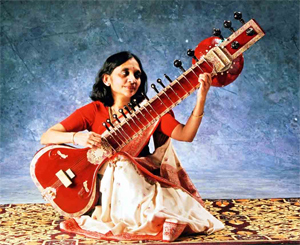Hasu Patel is a disciple of sitar legend Ustad Vilayat Khan Saheb. She is one of the few distinguished female artists performing today Classical Music on sitar. As a performer, composer and teacher, she has dedicated her life to preserving and propagating the classical music of India.
Born in the culturally rich city of Baroda, India, she began her musical studies in early childhood. Her father was her mentor who instilled the love and discipline needed to become a musician. At the age of 10, she made her first public appearance. And after many years of rigorous training under her illustrious Gurus Prof. N.B. Kikani and Ustad Anwar Khan Saheb. She became the first woman to receive a music degree with Gold medal in the history of the Faculty of Fine Arts Baroda. She has received many awards, scholarships and fellowships including at the age of 21 the first prize winner in the State of Gujarat for the stringed instrument competition held by All India Radio.
Shortly thereafter, she emigrated to the United States and has pursued music ceaselessly for over two decades. Hasu plays the sitar in a very special style known as ‘Gayaki Ang’ (Singing Style) where the sitar replicates fluidity and subtle nuances of the human voice which she learned from her Guru Ustad Vilayat Khan Saheb of Imdad Khani Gharana whose innovative technique of Gayaki Ang is his most significant contribution to music inheritance.She has performed the Classical Music of India known as ‘Raga Sangeet’ (scientific, precise, subtle and aesthetic system of melodic notes accompanied with rhythm of tremendous vitality on tabla”) at various performing art centers; music conferences; world music, jazz, and country music festivals such as Woodstock’s 30th anniversary and Chicago Jazz festival; universities; radio and television stations; churches, temples, meditation centers, etc. around the country.
Hasu Patel has conducted duets with Western Classical and Jazz musicians; many residences, workshops, lecture demonstrations in schools and colleges; and has offered her unique talent to terminally ill patients in hospitals as a music therapy. She has also performed as a musician in Indian Classical dance ensembles.
Hasu is affiliated with Ohio Arts Council (Ohio Artists on Tour 23-24); Greater Columbus Arts Council; Mid-America Arts Alliance and International Alliance of Women in Music. Hasu teaches sitar, tabla and vocal music to many area students at her Sursangam School of Music as well as credit hours course at Conservatory of Music at Oberlin College of Ohio.
“My Music, My Dream – It gives me an eternal pleasure when I play before music lovers around the world “. To her, Indian Classical music is a rare and divine art that calls for absolute dedication called Sadhana. “The more one plays, the more humility captivates one“.
Hasu’s debut album Gayaki sitar presented a bold Alap, improvisation which embodies the very essence of pure classicism. The music is spiritual and meditational, and rendered as such to bring forth the transcendental experience of the ‘rasas’ (moods).
Ms. Patel has a deep and wide interest as well as extensive experience collaborating with western musicians and dancers. She is very open to composing and improvising with artists from eastern and western traditions.
Discography:
Gayaki Sitar (1997)
Yaman Kalyan Raga / Kirwani (2017)


